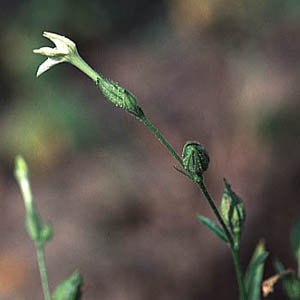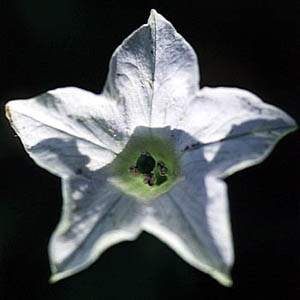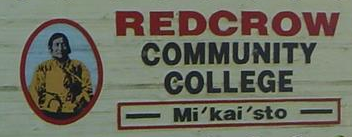Indian Tobacco – Nicotiana quadrivalvis Pursh

Traditional Blackfoot items.
(Photo courtesy of Glenbow Museum Archives NA-668-62)
Elder Carolla Calf Robe talks about the uses of Indian Tobacco and how you get the rights to use this plant.
Indian Tobacco

Nicotiana quadrivalvis Pursh
Galileo Educational Network
Native peoples have smoked tobacco for praying, for pleasure and as medicine for a very long time. The kind of tobacco that our ancestors smoked was very different than the tobacco that you buy in the store. Elder Carolla Calf Robe told us that Indian Tobacco seeds were planted in a ritual and while praying by the Tobacco Society. When this tobacco was picked, it came from straight from the land, and although other plants might have been added to it, chemicals and preservatives were not. For modern people smoking has become an addiction but to us, tobacco used in our ceremonial pipes is sacred, and smoking with others is a holy ritual and a way of honouring and including others from the community. The smoke from the ceremonial pipe is like the Great Spirit’s breath taking our prayers up. When you have a ceremonial pipe in your hand, you are to speak nothing but truth. This is really different than just smoking a cigarette or just a regular pipe.
The inner bark of Red-osier Dogwood and the dried leaves of the Kinnikinnik plant are often mixed with tobacco for smoking and are kept in our religious bundles. Sometimes dried sweetgrass and dried Rosy Pussy Toes are also mixed with tobacco and used in ceremonies.
The roots of the Sweetflag plant can be mixed with tobacco and the smoke inhaled. This smoke helps relieve toothaches and headaches. The smoke can also help you feel more alert if you are tired, like a cup of coffee might. A poultice of just tobacco can also be used for to draw out sickness from under the skin.
You can find Indian Tobacco growing wild on dry plains and mesas and on well-drained washes and slopes on the prairies and foothills. The star shaped white flowers bloom from June to August on the top of a long stem with skinny green leaves.
Tabac indien

Nicotiana quadrivalvis Pursh
James L. Reveal
Cela fait très longtemps que les Autochtones fument le tabac pour prier, pour s’amuser ou pour se guérir. Le tabac que nos ancêtres fumaient est très différent du tabac vendu en magasin de nos jours. Les graines de tabac indien étaient semées par la société du tabac, qui priait et suivait un certain rituel. Le tabac que les membres de cette société récoltaient venait droit de la terre. Même si d’autres plantes avaient pu y être mélangées, il n’y avait ni produit chimique, ni agent de conservation. De nos jours, fumer est une habitude chez les gens, mais pour nous, le tabac dont nous nous servons dans nos calumets est sacré. Le fait de fumer avec quelqu’un d’autre est un rituel sacré, une manière d’honorer et d’inclure les autres personnes de notre collectivité. Quand la fumée sort des calumets, c’est comme si le Grand Esprit venait apporter nos prières au ciel. Quand nous avons un calumet en main, nous devons toujours dire la vérité. Ce n’est pas du tout comme fumer une cigarette.
Souvent, nous mélangeons l’intérieur de l’écorce du cornouiller stolonifère et les feuilles séchées de la plante du raisin d’ours avec le tabac à fumer et nous les plaçons dans nos ballots sacrés. Parfois, nous faisons sécher du foin d’odeur et de l’antennaire rose pour les mélanger avec notre tabac destiné aux cérémonies. Les racines de la belle-angélique peuvent aussi être mélangées au tabac afin d’en inhaler la fumée. Cette fumée permet de soulager les maux de dents et les maux de tête. Elle peut aussi donner de l’énergie aux personnes fatiguées, un peu comme le café. Un cataplasme de tabac pur peut aider à faire sortir les maladies se logeant sous la peau.
Le tabac indien pousse à l’état sauvage dans les prairies sèches et les mesas, ainsi que dans les oueds ou les pentes des prairies et des piémonts. Ses fleurs blanches en forme d’étoiles sortent de juin à août au sommet d’une longue tige aux petites feuilles vertes.

Nicotiana quadrivalvis Pursh
James L. Reveal
- Calf Robe, C. (personal communication February 15, 2005)referred to Indian Tobacco.
- Hart, Jeff. (1992). Montana Native Plants and Early Peoples. Helena, Montana: Montana Historical Society Press.
- Hellson, John C. (1974). Ethnobotany of the Blackfoot Indians. Ottawa: National Museums of Canada.
- Johnston, Alex. (1987). Plants and the Blackfoot. Lethbridge, Alberta: Lethbridge Historical Society.
- Reveal, James, L. 2003, used with permission of The Academy of Natural Sciences in Philadelphia. (Earle & Reveal, Lewis and Clark’s Green World: Farcounty Press.) Retrieved Feburary 11, 2005 http://www.life.umd.edu/emeritus/reveal/pbio/slides13/13254b.jpg





